Handling injuries on the trail is essential for advanced hikers. Common issues include blisters, ankle sprains, cuts, heat-related illnesses, and hypothermia. Prevent blisters by using well-fitted footwear, and address cuts immediately with antiseptic wipes to avoid infections. Implement the R.I.C.E. method for sprains—rest the limb, apply ice, use compression bandages, and raise. Guarantee hydration to combat heat illnesses, and carry a first aid kit with adhesive bandages, antiseptic, and tweezers. Understanding when professional medical help is necessary can prevent severe complications. Mastering these techniques allows hikers to face challenges with confidence, enhancing their trail safety skills further.
Key Takeaways
- Use well-fitted boots and moisture-wicking socks to prevent blisters caused by friction.
- Apply the R.I.C.E. method for treating ankle sprains: Rest, Ice, Compression, and Elevation.
- Clean cuts and scrapes immediately with antiseptic wipes, and cover with sterile bandages to prevent infection.
- Stay hydrated and take shaded breaks to prevent heat-related illnesses and dehydration.
- Carry a fully stocked first aid kit, including adhesive bandages, antiseptic wipes, and a multi-tool for trail emergencies.
Recognizing Common Trail Injuries
When hitting the trails, hikers should be well-prepared to recognize the signs of common trail injuries that can disrupt an otherwise enjoyable outing. Awareness and early identification play vital roles in trail injury prevention and ensuring hiking safety.
Blisters, often resulting from friction due to ill-fitting footwear, are prevalent among hikers tackling long distances or rugged terrain. To prevent blisters, it's advisable to wear properly fitted hiking boots and moisture-wicking socks.
Ankle sprains, another common injury, occur when the ankle twists or rolls on unstable ground, leading to swelling and bruising. To reduce the risk, hikers should focus on strengthening ankle muscles and being cautious on uneven surfaces.
Cuts and scrapes from falls or sharp objects demand immediate attention; cleaning and covering them promptly helps prevent infection.
Heat-related illnesses, such as heat exhaustion and heat stroke, present symptoms like nausea, dizziness, and raised body temperature, especially in hot conditions. Staying hydrated and taking breaks in shaded areas are essential hiking safety tips.
Essential First Aid Kit Items
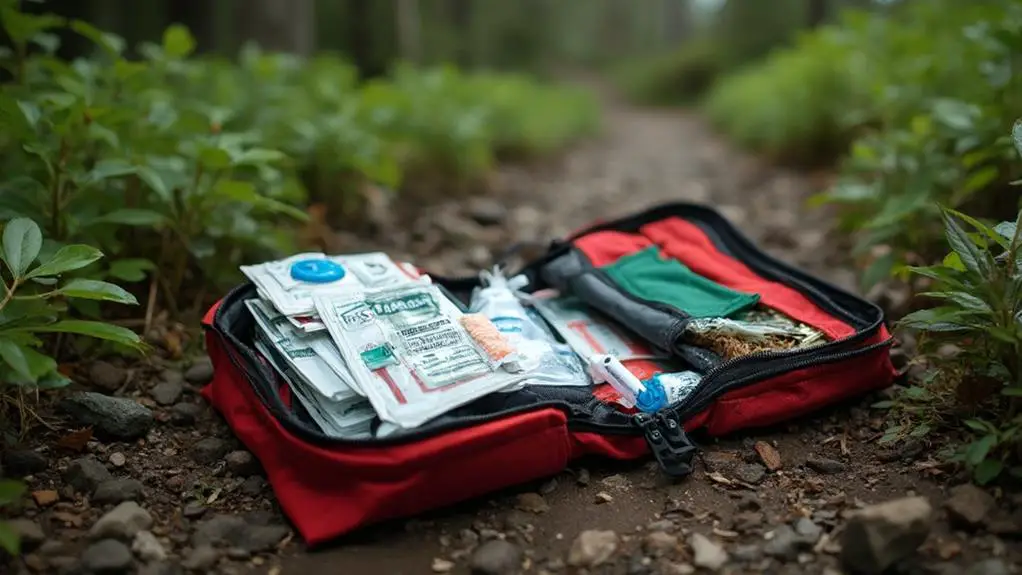
When assembling a first aid kit for advanced hikers, it is essential to include a variety of adhesive bandages, sterile gauze pads, and adhesive tape to effectively manage cuts and wounds encountered on the trail.
Additionally, antiseptic wipes and tweezers are important for preventing infections and removing foreign objects such as splinters or ticks.
To guarantee thorough preparedness, hikers should also pack a multi-tool or scissors, personal medications, a space blanket, hydration tablets, and moleskin to address both environmental challenges and hiking-related injuries.
Key First Aid Supplies
A thorough first aid kit is an indispensable component of a hiker's gear, particularly for those venturing into more remote and challenging terrains. First aid essentials are essential for injury prevention and effective response to unexpected medical situations.
An advanced hiker's kit should be well-stocked with adhesive bandages of various sizes, sterile gauze pads, and adhesive tape to manage common trail injuries such as cuts and scrapes. Antiseptic wipes and antibiotic ointment play a significant role in disinfecting wounds, thereby preventing infections that can escalate in outdoor environments.
Tweezers are necessary for removing splinters or ticks, while scissors serve a dual purpose in cutting gauze or tape during emergencies. Personal medications, including an EpiPen for severe allergic reactions and any necessary prescription drugs, are imperative for addressing individual health needs.
Additionally, a space blanket and whistle serve as supplementary safety items, offering warmth and signaling capabilities in dire situations. A multi-tool also provides versatile utility, making it a valuable addition to any first aid kit.
Together, these supplies guarantee hikers are well-prepared to handle minor and moderate injuries, enhancing safety and self-sufficiency on the trail.
Emergency Treatment Tools
Emergency treatment tools are essential components of any hiker's first aid kit, ensuring preparedness for a range of unforeseen medical situations that may arise on the trail. A well-stocked kit is important for effective wound care and emergency response.
It should contain adhesive bandages in various sizes, which are indispensable for protecting minor cuts and abrasions. Sterile gauze pads are critical for managing larger wounds, while adhesive tape helps secure these dressings in place, ensuring they remain effective during physical activity.
Antiseptic wipes play a significant role in cleaning wounds, reducing the risk of infection before applying bandages or ointments. Tweezers are another key tool, necessary for removing splinters or ticks, both common trail nuisances. Scissors are invaluable for cutting tape or gauze to the appropriate size, allowing for tailored wound care solutions.
Additionally, a space blanket serves as an emergency response tool, offering warmth and shelter in cases of sudden weather changes or injuries that immobilize a hiker.
Personal medications, including an EpiPen for severe allergic reactions and any prescription medications, should be included to address specific health needs, ensuring thorough preparedness on the trail.
Managing Blisters Effectively
Blisters, a common ailment for hikers, are fluid-filled pockets that arise from the friction between skin and footwear, often aggravated by moisture and ill-fitting socks or shoes. Implementing effective blister prevention strategies is essential to maintaining comfort and mobility on the trail.
Start by selecting moisture-wicking socks and well-fitted, broken-in footwear to minimize friction. Additionally, apply blister prevention tape to known hot spots on your feet to create a protective barrier, reducing the likelihood of blister formation.
Despite preventive measures, blisters may still develop. When this occurs, certain blister care techniques are vital to manage the condition effectively. If a blister remains intact, keep it clean and covered with a sterile bandage to protect it from further irritation and potential infection.
Avoid popping the blister unless absolutely necessary, as this can increase the risk of infection. For blisters that have already popped, clean the area thoroughly with antiseptic, apply a topical antibiotic, and protect it with a non-stick dressing to encourage healing.
Regular monitoring and maintaining foot hygiene during hikes are paramount. Keeping feet dry and clean, coupled with vigilant care, can greatly reduce the occurrence of blisters and promote a more enjoyable hiking experience.
Treating Sprains and Strains
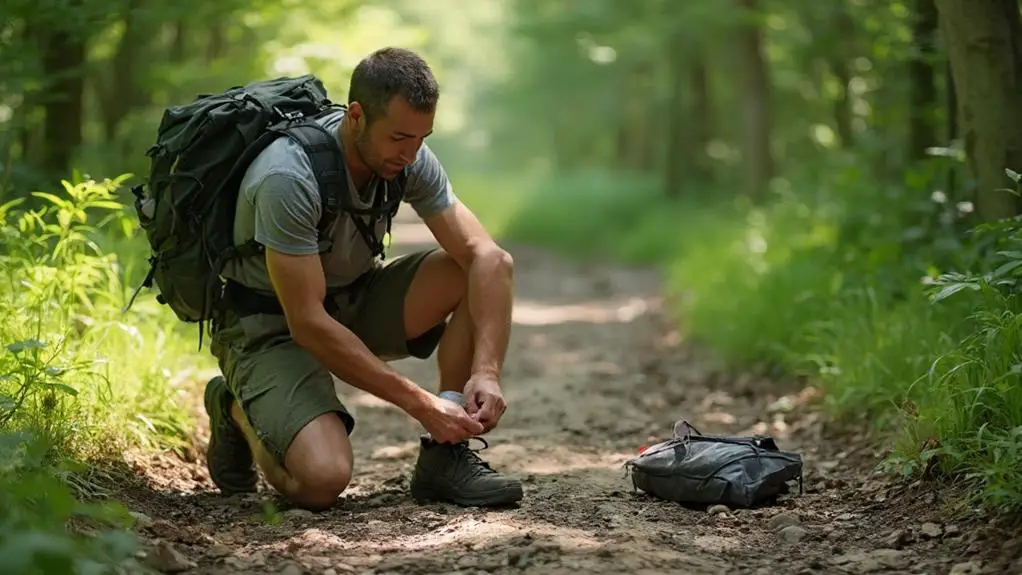
When faced with sprains and strains on the trail, implementing the R.I.C.E. method—Rest, Ice, Compression, and Elevation—is vital to minimize swelling and expedite recovery.
It's essential to rest the affected area, apply ice for 15-20 minutes every few hours, use an elastic bandage for compression, and keep the injury elevated above heart level.
For hikers needing to move despite the injury, splinting can provide the necessary stability and support, but if severe pain continues, seeking medical attention becomes imperative to rule out more serious conditions.
Effective RICE Method
The R.I.C.E. protocol—an acronym for Rest, Ice, Compression, and Elevation—remains a cornerstone in the effective management of sprains and strains, imperative for hikers who may encounter these injuries on the trail.
Resting the injured area is paramount; this avoids placing weight on the affected limb, thereby preventing further damage and facilitating the healing process. Regarding rehabilitation techniques, early and appropriate rest sets the stage for a more streamlined recovery, reducing the likelihood of future complications.
Applying ice to the injury, ideally for 15-20 minutes every 2-3 hours, plays a significant role in minimizing swelling and numbing pain. A cloth should be used as a barrier to protect the skin from direct exposure to ice. This step is essential for injury prevention, as uncontrolled swelling can lead to prolonged recovery times.
Compression, facilitated by an elastic bandage, provides support and assists in managing swelling. It is critical to ascertain that the bandage is snug but not overly tight, to maintain adequate blood flow.
Elevating the injured limb above heart level further aids in swelling reduction and enhances circulation, thereby promoting a more efficient recovery process.
Mobility With Splinting
In the event of a sprain or strain while hiking, guaranteeing mobility with proper splinting is vital to prevent further injury and facilitate safe movement. Employing makeshift splinting techniques can provide necessary stability until advanced splinting materials are available. Begin by following the R.I.C.E. method to minimize swelling and promote healing: Rest, Ice, Compression, and Elevation. For swift mobility assistance, create a makeshift splint using trekking poles, sticks, or sturdy clothing. These resources serve as effective stabilizers to prevent exacerbation of the injury.
Ice the affected area for 15-20 minutes every 2-3 hours, utilizing natural ice sources when possible. Compression is essential; use spare clothing or elastic wraps to fashion a supportive bandage, thereby limiting swelling around the joint or muscle. Raise the injured limb above heart level whenever feasible to decrease swelling and enhance circulation.
| Item | Purpose |
|---|---|
| Trekking poles | Provide structure for splint |
| Sticks | Stabilize injured area as splint |
| Clothing | Used for compression bandage |
| Elastic wraps | Offer advanced compression support |
| Natural ice sources | Reduce swelling and pain |
These practical techniques guarantee hikers maintain mobility and safety on the trail, even when injuries occur.
Addressing Cuts and Scrapes
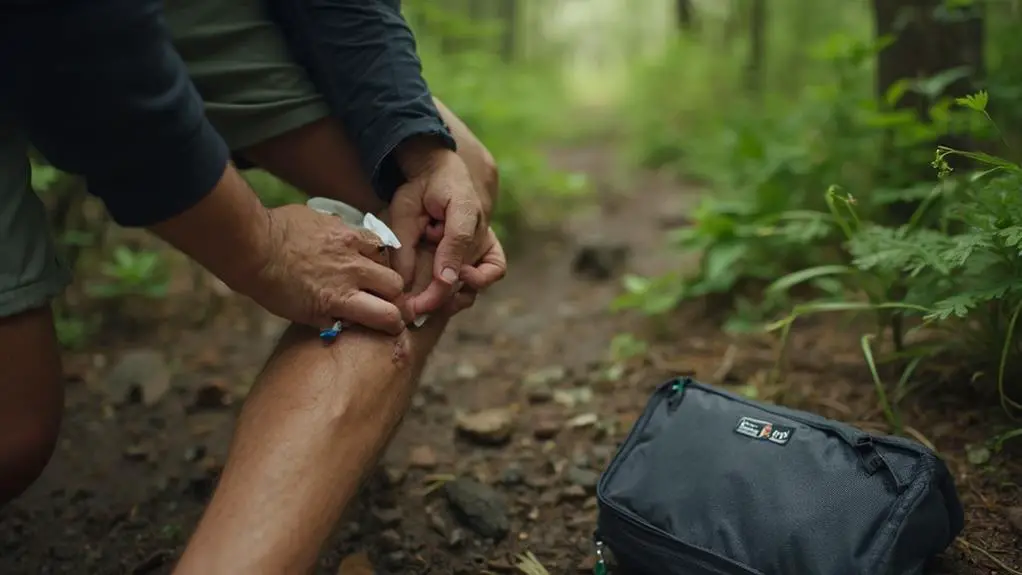
Hikers' journeys often involve traversing rugged terrains, which can lead to encountering cuts and scrapes despite preventive measures. To minimize the risk, wearing long pants and sleeves acts as a barrier against sharp objects and underbrush.
However, when injuries do occur, immediate and effective wound care is essential to prevent infection and promote healing.
Begin by cleaning the wound with soap and clean water; if absent, antiseptic wipes from your first aid kit serve as an alternative. This step is critical in reducing infection risk.
Once clean, apply direct pressure to halt bleeding. For smaller cuts, use sterile gauze or adhesive bandages to cover the area, guaranteeing it remains clean and protected.
In cases of larger cuts with severe bleeding, applying a tourniquet using clothing or a belt may be necessary, followed by seeking medical attention promptly.
Vigilance in monitoring the wound is important; watch for signs of infection such as redness, warmth, swelling, or pus. Change dressings regularly to facilitate proper healing.
These measures guarantee that hikers can address cuts and scrapes effectively, maintaining their ability to safely continue their outdoor adventures.
Preventing and Managing Hypothermia
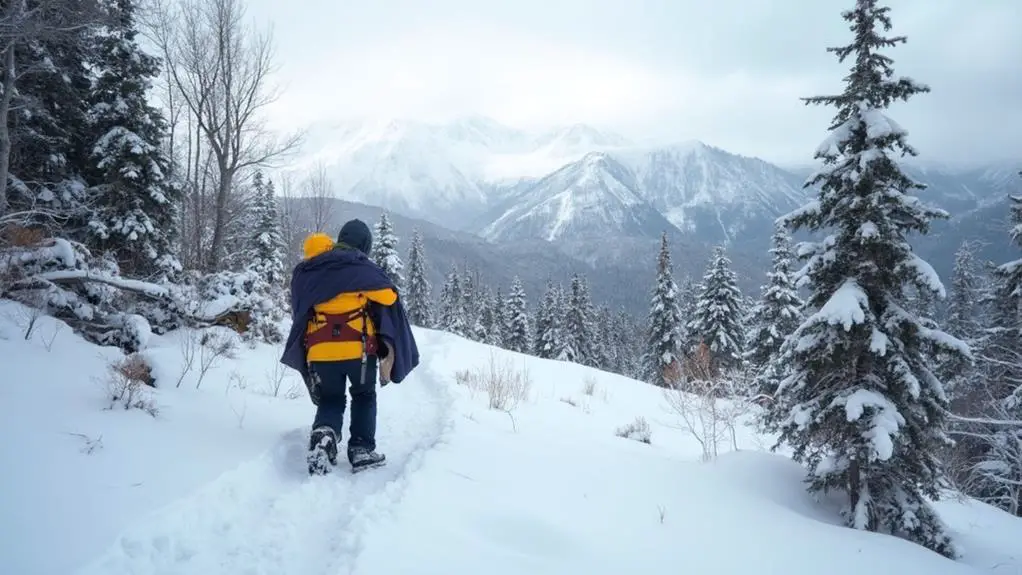
Managing hypothermia involves more than just understanding its dangers; it requires strategic preparation and intervention. Hypothermia, defined by a core body temperature drop below 95°F (35°C), often results from prolonged exposure to cold and wet environments.
Advanced hikers must prioritize layered clothing to effectively trap body heat while allowing for flexibility in temperature regulation. Utilizing moisture wicking fabrics is essential, as these materials draw perspiration away from the skin, maintaining dryness and preserving warmth. Avoid cotton, which can retain moisture and lose its insulating properties when wet, increasing the risk of hypothermia.
Recognizing early symptoms such as shivering, confusion, fatigue, and slurred speech is critical for timely intervention. If hypothermia is suspected, immediate action is necessary. Seek an emergency shelter to protect against further heat loss.
Remove any wet clothing and initiate gradual warming using blankets or sleeping bags, ensuring that the process is controlled to prevent shock. Carrying an emergency space blanket or bivvy bag can provide essential insulation in such situations, greatly reducing heat loss.
Combating Dehydration and Heat Illnesses
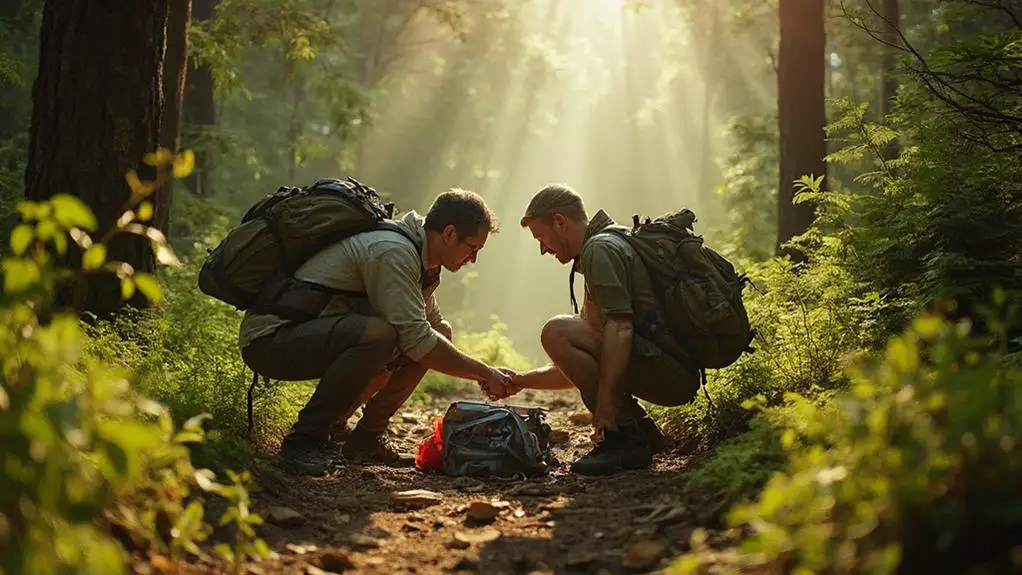
While hypothermia poses a notable threat in cold environments, dehydration and heat illnesses can be equally perilous in warmer conditions. Dehydration occurs when the body loses more than 2% of its water weight, often resulting in headaches, dizziness, and fatigue, which can critically impair hiking performance.
To maintain ideal hydration levels, it is recommended that hikers consume 16-32 ounces of water per hour during strenuous activities, adjusting based on temperature, humidity, and individual sweat rates. Effective hydration strategies include consuming electrolyte-rich fluids to replenish lost salts due to sweating, which is vital for sustaining energy and bodily functions.
Heat illness prevention is essential during hikes in hot climates. Heat exhaustion, which manifests with heavy sweating, weakness, and nausea, can occur when the body temperature rises between 100°F and 103°F. Immediate rest and hydration are necessary to prevent progression to heat stroke, a severe condition where body temperature exceeds 104°F, leading to confusion, rapid heartbeat, and potential loss of consciousness.
To combat these risks, hikers should wear lightweight, breathable clothing, and take regular breaks in shaded areas. Recognizing early symptoms and responding promptly can greatly reduce the risk of serious heat-related illnesses.
Knowing When to Seek Help
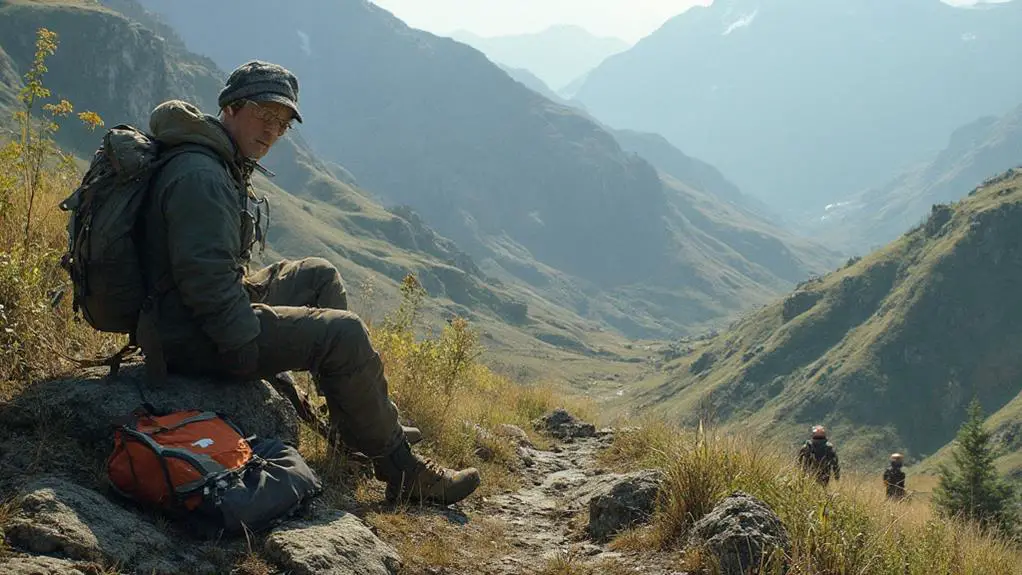
Recognizing the vital point at which professional medical help is necessary can be important for hikers facing unexpected health challenges on the trail.
Accurate injury assessment and the ability to determine the need for urgent care can make a significant difference in outcomes, especially in remote environments. Certain situations demand immediate attention from medical professionals to guarantee safety and prevent further complications.
- Severe Pain or Deformity: Immediate medical attention is essential if you experience severe pain, inability to bear weight, or visible limb deformity. These symptoms could indicate serious issues such as fractures, which require urgent care.
- Persistent Swelling or Bruising: If swelling or bruising doesn't subside with initial treatment, or if there's a limited range of motion, it's important to seek medical consultation. This guarantees any potentially significant damage is not overlooked.
- Signs of Infection: Increased redness, warmth, pus, or fever following any cut or scrape necessitates prompt medical evaluation to prevent infection from escalating.
- Heat-related Symptoms or Altitude Sickness: Symptoms like confusion, rapid heartbeat, or a core temperature above 104°F indicate heat stress needing emergency intervention.
Similarly, severe headaches, nausea, or breathing difficulties at high altitudes require descent and medical attention to manage possible altitude sickness effectively.
Frequently Asked Questions
How Can I Prepare Mentally for Handling Emergencies on the Trail?
Developing mental resilience and cultivating an emergency mindset are essential. Engage in scenario-based training, visualize potential challenges, and practice stress management techniques. This preparation enhances decision-making and maintains composure, ensuring effective responses during unforeseen trail emergencies.
What Are Some Signs of Altitude Sickness I Should Watch For?
Recognizing symptoms of altitude sickness is essential; watch for headaches, dizziness, nausea, and shortness of breath. Prevention strategies include gradual ascent, staying hydrated, and acclimatization. Early intervention is key to mitigating risks and ensuring a safe hiking experience.
How Do I Safely Transport an Injured Hiker to Get Help?
To safely transport an injured hiker, utilize proper evacuation techniques such as creating a makeshift stretcher or employing a buddy carry. Prioritize stabilizing the injury, communicating clearly, and ensuring a safe, steady pace to minimize further harm.
Are There Specific First Aid Certifications Beneficial for Advanced Hikers?
Advanced hikers should consider obtaining wilderness first aid and advanced certifications, such as Wilderness First Responder (WFR). These programs offer practical skills and knowledge essential for managing medical emergencies in remote environments, enhancing safety and preparedness.
What Communication Devices Are Recommended for Emergency Situations on Remote Trails?
For emergency situations on remote trails, advanced hikers are advised to carry satellite phones and emergency beacons. Satellite phones guarantee reliable communication, while emergency beacons provide accurate location data to facilitate timely rescue operations, enhancing overall safety.
Conclusion
In summary, advanced hikers must be equipped with the knowledge and tools necessary to address a variety of trail injuries effectively. Understanding common injuries, such as blisters, sprains, cuts, and dehydration, is essential for appropriate management. Maintaining a well-stocked first aid kit, recognizing symptoms of hypothermia and heat illnesses, and knowing when to seek professional help are vital components of trail safety. By implementing these strategies, the likelihood of serious complications can be minimized, ensuring a safer hiking experience.